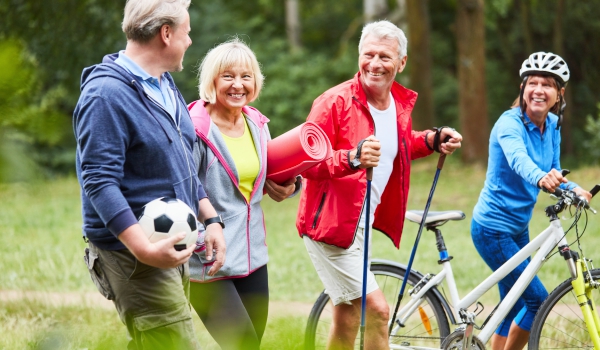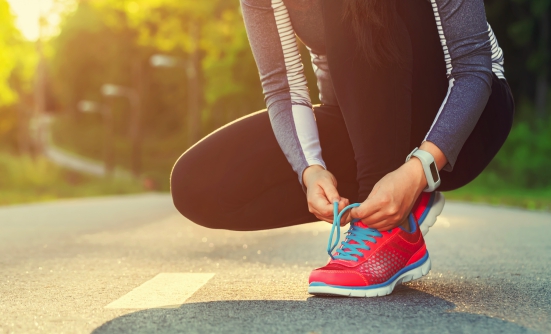
We know that regular exercise and physical movement improve your health. They also may lower your risk of developing some diseases, like certain cancers. But what you may not know is that exercise and physical movement during and after cancer treatment might also be beneficial. Movement has been shown to relieve some of the side effects of cancer therapies, help treatments be more effective, and reduce mental stress and depression.1-3 This, in turn, can help you stick to your treatment plan, which increases your chance of remission or cure.
Every person is different, even those who have the same cancer diagnosis. So, exercise and movement also affect people in different ways. What is important for you to know about exercise and movement if you have cancer?
What Do We Mean by Exercise and Movement?
Physical activities are what you do every day. You get out of bed, brush your teeth, cook meals, walk, and so on. Every time you move your skeletal muscles, the ones you use to make the movements to perform those tasks, you do some sort of physical activity.4,5
Physical activities are what you do every day....exercise, on the other hand, is a deliberate, intentional way of moving your body to increase (or maintain) fitness.
Exercise, on the other hand, is a deliberate, intentional way of moving your body to increase (or maintain) fitness.6 There are different levels of exercise, ranging from mild, such as walking around the block and doing tai chi, to extreme, such as running marathons or engaging in competitive bodybuilding. And there are many levels in between.
When you’re not feeling well, the idea of doing any type of exercise may seem overwhelming. This is where the idea of movement comes in. Standing up frequently so you’re not sitting for long periods can be helpful. Walking up and down the hall while you talk on the phone or text also gets you moving. Getting out and about, going for walks or grocery shopping, or working in the garden are all ways you can move and get some physical activity.
Tai chi, a very gentle form of exercise that originated in China, has several benefits, including improving balance, muscular strength, and flexibility.7 Yoga can be gentle or more advanced, depending on the poses. Many physical and mental health conditions are related to or made worse by stress. Randomized controlled trials have shown that these 2 mind-body practices improve health outcomes and quality of life in several ways.8 Some conditions that yoga and tai chi may help include:
- Chronic pain
- Anxiety
- Depression
- Insomnia
- Cancer-related fatigue
- Tobacco addiction
- Inflammatory bowel disease
- Heart disease.
As you become stronger or less fatigued, you can increase the amount of activity or add new and different poses.
Different Types of Exercise30
Aerobic: The goal of aerobic exercise, also called “cardio,” is to work the heart, making blood pump more quickly throughout your body. Aerobics is continuous over a set time, like 30 minutes or so. This makes your heart stronger and lowers blood pressure. Aerobic exercise may also prevent some diseases, such as type 2 diabetes, and some types of cancer, as well as improve muscle and bone strength, and balance.30,31 Examples include:
- Outdoor chores (lawn mowing, gardening)
- Walking
- Cycling
- Rowing
- Swimming
- Dancing
- Tennis.
Resistance: Resistance exercise or training is specific to certain parts of the body, such as the arms, the legs, and the abdomen (core). Rather than a specific time, someone doing resistance work may use weights, a machine, or resistance bands a certain number of times (repetitions) to work on a specific muscle group.2
Balance and flexibility: These exercises help reduce your risk of falling. Falling is a serious concern for people with weakened bones that can often happen with cancer treatment. Examples of balance exercises include32:
- Yoga
- Tai chi
- Stretching
- Dance.
Easing Some Issues Related to Cancer Treatment
We know that research shows that exercise not only helps people prevent some diseases but that it can also actively help you when you are going through treatments, such as chemotherapy or radiation therapy.
Exercise not only helps prevent some diseases but it can also actively help when you are going through treatments, such as chemotherapy or radiation therapy.
As a rule, experts recommend that adults get at least 150 minutes per week of moderate-intensity exercise.9 Experts recommend that people recovering from cancer treatment ease into regular exercise, with moderate aerobic exercise for at least 30 minutes, 3 times a week for at least 8 to 12 weeks.10 They can also add resistance training at least twice a week.
Cancer treatments can cause side effects and unintended consequences, which can decrease quality of life and may cause people to stop their treatments.
Chemotherapy and radiation therapy can cause issues such as11,12:
- Fatigue
- Insomnia
- Poor appetite
- Foggy thinking
- Nausea
- Bone density loss.
- Surgery can cause1:
- Pain
- Lymphedema (build-up of fluid in soft body tissues because a lymph node is blocked or damaged)
- Contractions due to scars.
Studies show that performing a combination of physical movements is better than sticking with one type. For example, to help ease cancer-related fatigue, you can combine aerobic and resistance exercise, yoga, and other types of regular physical activity.13 Two recent reports suggested that some cancer patients had significant improvement in their sleep issues when they did regular aerobic exercise. Patients who did a combination of aerobic and resistance (strength) training showed improvements in their bone mineral density, strengthening their bones.14,15 Stretching exercises also may break down scar tissue and restore range of motion after cancer surgery. Some studies show that certain types of exercise, such as water-based ones, may improve lymphedema in some patients.16,17 Patients with lymphedema should discuss this with their cancer care team first.
Exercise Can Help Improve Chances of Survival, Reduce Risk of Recurrence
When cancer patients undergo treatment, they often worry about the treatment and their future. The good news is research shows that not only can exercise help you manage some problems related to your therapy, but it may also increase your chances of surviving and reduce the chances of the cancer returning.2,18,19
Studies that looked at women who had breast cancer and whether they took part in recreational physical activity showed that those who were most physically active had the highest survival rates and lowest recurrence rates.
The researchers don’t know exactly why this happens, but they suggest that it’s likely a combination of things. Regular exercise during cancer treatment can:
- Reduce the number of sex hormones and proteins that can promote certain types of cancer growth19
- Affect the muscles, allowing them to produce proteins that might help control cancerous cells by stimulating your immune system and combating cancer-induced muscle loss3
- Help you lose weight, if needed, and reduce inflammation that can also contribute to cancer recurrence19
- Improve mental health, which helps you to want to continue treatment.20
How Exercise Helps Your Mind

Having cancer doesn’t affect you just physically. It does so mentally as well. Up to one-third of people with cancer can experience depression, and nearly half report having anxiety.21-23 Interestingly, anxiety and depression are not always the result of knowing you have cancer though. It seems that certain types of cancer, like pancreatic cancer and lung cancer, may release chemicals that can cause depression. And some cancer treatments do cause depression as a side effect.24
Some people who were taking antidepressants before they were diagnosed with cancer may have to stop or change their medications. Some antidepressants may interfere with certain chemotherapy drugs, and some can make cancer symptoms worse.24
This is where physical activity and exercise may play an important role. Researchers have been studying how people with cancer react to aerobic exercise. Here are some study findings:
- Patients receiving chemotherapy or radiation therapy for breast cancer had better sleep and less depression and anxiety if they walked at a moderate rate for 10 to 15 minutes 4 to 6 days a week2
- Breast cancer patients on chemotherapy who did regular aerobic exercise with a treadmill, cycle ergometer (stationary bike), or elliptical trainer 3 times a week experienced less anxiety2
- Patients receiving chemotherapy for colorectal cancer who walked at a moderate rate for 20 to 30 minutes a day, 3 to 5 days a week had less anxiety and depression, and said they had a better quality of life2
- Another group of patients with cancer who had stem cell transplants after high-dose chemotherapy had less psychological distress if they used a cycle ergometer for half an hour per day, 7 days a week. (Their program was 1 minute of pedaling, 1 minute rest, for a total of 15 minutes of exercise.)2
Getting out to exercise also can keep you from becoming isolated and feeling alone.25 You could join a gym, a fitness class such as yoga, Pilates, or tai chi, or join a local walking group—whatever feels right for you.
Purposeful Inefficiency
We all know how to find ways to work more efficiently, but sometimes making your workstation or living area inefficient on purpose can help you move more. Little things add up!
- If you have a home office, place your printer on the other side of the room (or in another one) so you must get up to get your printouts
- If you do arts and crafts, like quilting for example, put your ironing board or other important part of the process on the other side of the room so you will stand up regularly
- Place your cups or mugs on the opposite side of the kitchen from your coffee maker or kettle
- Leave your phone in another room so you must get up to answer it or see what someone has texted
- Leave your recycling bin in the garage, laundry room, or near a back door so you must walk over to deposit your recyclables
- Park farther away from your destination so you must walk a bit (or a lot).
Improving Heart Health While You Have Cancer
Having cancer puts you at higher risk for other health problems. For example, just as some medications used to treat cancer can cause bone loss, leading to osteoporosis (thinning of the bones), others can damage your heart.26,27 A weight-bearing and resistance exercise program tailored for you could help lessen this risk or the damage in different ways.28
Exercise can help limit or reduce weight gain, which is a known risk factor for heart disease and certain cancers. It can help lower cholesterol levels and high blood pressure as well.28
Exercise can help limit or reduce weight gain, which is a known risk factor for heart disease and certain cancers. It can help lower cholesterol levels and high blood pressure as well.
Life After Cancer Treatment
Cancer treatments are advancing and becoming more personalized. It’s estimated there are over 18 million cancer survivors in the United States alone.29 Having been touched by cancer, you know firsthand the impacts of cancer treatment. Given how challenging treatment can be, it’s exciting that something as simple, affordable, and accessible as incorporating intentional movement practices into your life can pay such great dividends.
Maintaining a movement practice throughout your cancer journey can help you manage treatment side effects, may decrease the risk of recurrence, and possibly even prevent new cancers. In addition, daily movement can improve the quality of your life, regardless of cancer stage or grade, by optimizing your mental well-being. Lastly, regular movement practices can also help prevent or manage diabetes, obesity, pain, and other chronic diseases.
To learn more about making plans for movement during and after cancer treatment, visit:
The American College of Sports Medicine: Exercise is Medicine. This international site provides you with information about physical activity and its benefits in preventing and treating cancer. Select your country and the type of information you are looking for. The Cancer Registry Results will appear below.
The Academy also has a downloadable sheet that reviews the effects of exercise on people with cancer.
The Susan G. Komen Foundation worked with YogaWorks to develop live and on-demand yoga classes for people affected by breast cancer.

To receive a digital sample Viver guide to healthy eating, please click here and fill out a short survey »
About the Author
Lauri has 25+ years of clinical experience, most recently serving as the medical director of the University of New Mexico’s Integrative Medicine Clinic since 2020. She graduated from Duke University’s Leadership in Integrative Medicine Program and is a board-certified general surgeon in rural Colorado, practicing in multicultural settings. She is involved with the Academic Consortium of Integrative Medicine and Health’s research partner, the BraveNet Collaborative.

About Viver Health (viverhealth.com)
Viver’s Mission is Total Patient Care. Viver develops solutions that blend evidence-based clinical and holistic interventions to improve patient experiences and health outcomes. Our integrative resources address all aspects of a patient’s health, including symptom management, nutrition, and lifestyle guidance.
References
- Brown JC, Winters-Stone K, Lee A, Schmitz KH. Cancer, physical activity, and exercise. Compr Physiol. 2012;2:2775-2809. doi: 10.1002/cphy.c120005
- Mustian KM, Sprod LK, Janelsins M, et al. Exercise recommendations for cancer-related fatigue, cognitive impairment, sleep problems, depression, pain, anxiety, and physical dysfunction: a review. Oncol Hematol Rev. 2012;8:81-88. www.ncbi.nlm.nih.gov/pmc/articles/PMC3647480/
- Papadopetraki A, Maridaki M, Zagouri F, et al. Physical exercise restrains cancer progression through muscle-derived factors. Cancers (Basel). 2022;14:1892. doi: 10.3390/cancers14081892
- McCuller C, Jessu R, Callahan AL. Physiology, Skeletal Muscle. PubMed. Published 2020. www.ncbi.nlm.nih.gov/books/NBK537139/
- World Health Organization. Physical activity. Published October 5, 2022. www.who.int/news-room/fact-sheets/detail/physical-activity
- Penn State College of Medicine Research. Exercise vs. Physical Activity. https://research.med.psu.edu/oncology-nutrition-exercise/patient-guides/exercise-vs-activity/
- National Center for Complementary and Integrative Health. Tai Chi: What You Need To Know. Published March 2022. www.nccih.nih.gov/health/tai-chi-what-you-need-to-know
- Dossett ML, Fricchione GL, Benson H. A new era for mind-body medicine. N Engl J Med. 2020;382:1390-1391. doi: 10.1056/NEJMp1917461
- Centers for Disease Control and Prevention. How much physical activity do adults need? Published June 2, 2022. www.cdc.gov/physicalactivity/basics/adults/index.htm
- Campbell KL, Winters-Stone KM, Wiskemann J, et al. Exercise Guidelines for Cancer Survivors: Consensus Statement from International Multidisciplinary Roundtable. Med Sci Sports Exerc. 2019;51:2375-2390. doi: 10.1249/MSS.0000000000002116
- MedlinePlus Medical Encyclopedia. Chemotherapy. Published 2014. https://medlineplus.gov/ency/article/002324.htm
- National Cancer Institute. Sleep Problems in People with Cancer. Published April 29, 2015. www.cancer.gov/about-cancer/treatment/side-effects/sleep-problems
- Dong B, Qi Y, Lin L, et al. Which exercise approaches work for relieving cancer-related fatigue? A network meta-analysis. J Orthop Sports Phys Ther. 2023;53:343-352. doi: 10.2519/jospt.2023.11251
- Atoui S, Coca-Martinez M, Mahmoud I, et al. Exercise intervention in cancer patients with sleep disturbances scheduled for elective surgery: systematic review. Int J Surg. 2021;93:106069. doi: 10.1016/j.ijsu.2021.106069
- Singh B, Toohey K. The effect of exercise for improving bone health in cancer survivors – a systematic review and meta-analysis. J Sci Med Sport. 2022;25:31-40. doi: 10.1016/j.jsams.2021.08.008
- Maccarone MC, Venturini E, Menegatti E, et al. Water-based exercise for upper and lower limb lymphedema treatment. J Vasc Surg Venous Lymphat Disord. 2023;11:201-209. doi: 10.1016/j.jvsv.2022.08.002
- Lin Y, Wu C, He C, et al. Effectiveness of three exercise programs and intensive follow-up in improving quality of life, pain, and lymphedema among breast cancer survivors: a randomized, controlled 6-month trial. Support Care Cancer. 2022;31:9. doi: 10.1007/s00520-022-07494-5
- Morishita S, Hamaue Y, Fukushima T, et al. Effect of exercise on mortality and recurrence in patients with cancer: a systematic review and meta-analysis. Integrative Cancer Therapies. 2020;19:1534735420917462. doi: 10.1177/1534735420917462
- Zagalaz-Anula N, Mora-Rubio MJ, Obrero-Gaitan E, Del-Pino- Casado R. Recreational physical activity reduces breast cancer recurrence in female survivors of breast cancer: a meta-analysis. Eur J Oncol Nurs. 2022;59. www.ejoncologynursing.com/article/S1462-3889(22)00070-9/fulltext
- Misiag W, Piszczyk A, Szymańska-Chabowska A, Chabowski M. Physical activity and cancer care—a review. Cancers (Basel). 2022;14:4154. doi: 10.3390/cancers14174154
- Hartung TJ, Brähler E, Faller H, et al. The risk of being depressed is significantly higher in cancer patients than in the general population: prevalence and severity of depressive symptoms across major cancer types. Eur J Cancer. 2017;72:46-53. doi: 10.1016/j.ejca.2016.11.017
- Cancer.net. Depression. Published October 2022. www.cancer.net/coping-with-cancer/managing-emotions/depression
- Fardell JE, Irwin CM, Vardy JL, Bell ML. Anxiety, depression, and concentration in cancer survivors: National Health and Nutrition Examination Survey results. Support Care Cancer. 2023;31:272. doi: 10.1007/s00520-023-07710-w
- Pitman A, Suleman S, Hyde N, Hodgkiss A. Depression and anxiety in patients with cancer. BMJ. 2018;361:k1415. doi: 10.1136/bmj.k1415
- Cancer Research UK. What are the benefits of exercise? Reviewed September 15, 2023. www.cancerresearchuk.org/about-cancer/causes-of-cancer/physical-activity-and-cancer/what-are-the-benefits-of-exercise
- Guise TA. Bone loss and fracture risk associated with cancer therapy. Oncologist. 2006;11:1121-1131. doi: 10.1634/theoncologist.11-10-1121
- National Cancer Institute. Heart Problems: Investigating the Cardiac Side Effects of Cancer Treatments. Published September 21, 2018. www.cancer.gov/news-events/cancer-currents-blog/2018/cancer-treatment-heart-side-effects
- D’Ascenzi F, Anselmi F, Fiorentini C, et al. The benefits of exercise in cancer patients and the criteria for exercise prescription in cardio-oncology. Eur J Prev Cardiol. 2021;28:725-735. doi: 10.1177/ 2047487319874900
- American Association for Cancer Research. AACR Cancer Progress Report. Cancer in 2023. https://cancerprogressreport.aacr.org/progress/cpr23-contents/cpr23-cancer-in-2023/
- MedlinePlus. Aerobic exercise. Accessed January 25, 2024. https://medlineplus.gov/ency/imagepages/19383.htm
- Mulcahey M. Aerobic Exercise. OrthoInfo. American Academy of Orthopaedic Surgeons. www.orthoinfo.org. Published December 2019. https://orthoinfo.aaos.org/en/staying-healthy/aerobic-exercise/
- Medline Plus. Exercise and Physical Fitness. Published 2012. https://medlineplus.gov/exerciseandphysicalfitness.html
















